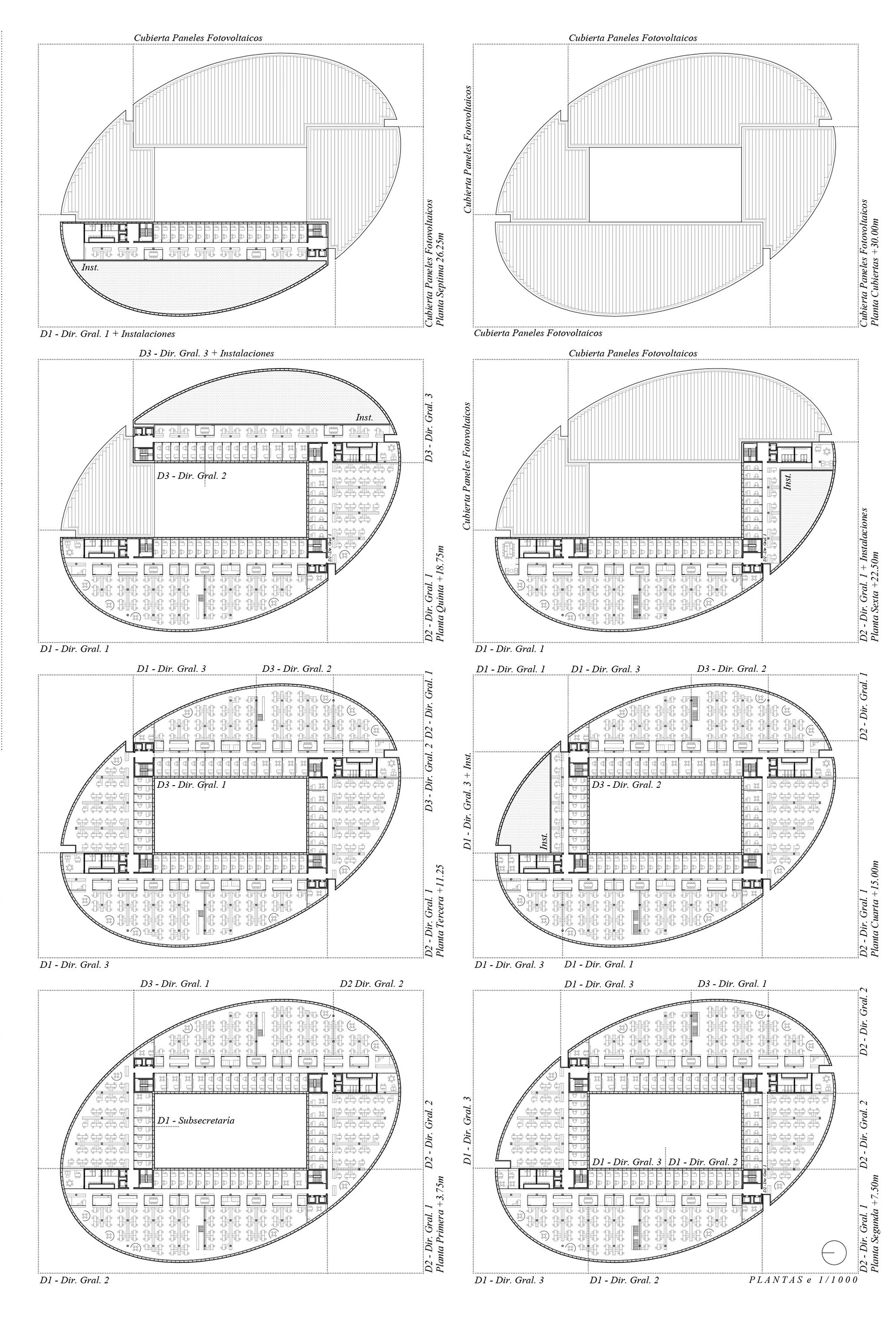They have also highlighted its appropriate and successful sustainability criteria and its bioclimatic decisions when designing the building.
The volume engages in a dialogue with its surroundings, located in the centre of the plot, it marks a boundary that makes us differentiate between two different languages that are at the same time in harmony. It is set back from the street, a decision that favours the quality of the project and rejects the traditional alignment of the street.
Its characteristic ellipse-shaped layout has allowed them not to modify the distribution of the workspaces, thus maintaining their functionality. Inside the ellipse, there is a rectangular courtyard that shows an orthogonal and straight organisation of the offices, an idea that contrasts with its curved exterior shape, symbolically representing 'the shape of the city'.

PD52 by Cruz y Ortiz Arquitectos. Rendering by Show Me The Project.

Facilities plans and photovoltaic modules. PD52 by Cruz y Ortiz Arquitectos.
Project description by Cruz y Ortiz Arquitectos
The triangular shape of the site is one of the challenges of the competition. The modular organisation of the office programme should avoid the obliquity of the layout. The unitary organisation of the proposal as a whole must therefore seek a gravitational centre that distances itself from the complexity of the corners. Our proposal offers the rotundity of a building absorbed in its outline, imposing and significant, which has the capacity to show itself to the city as an institutional reference within the urban fabric. Set back from the main alignments, the elliptical shape allows for unity and continuity in its façade without, due to its size, this curved geometry altering the functional organisation of the workspaces.
The main volume sits as a boundary element within the composition of the surrounding open blocks, where its shape represents its condition of edge, of limit, between one type of city and another and whose footprint, which can be recognised from the air, becomes one of the landmarks of the city of Madrid. Situated approximately on the geometric centre of the plot, the volume respects a spatial distance that allows it to dialogue with its surroundings while maintaining a certain formal autonomy. The elliptical outline negates the street alignments and the triangular outline of the site, creating an intermediate space between the triangle and the ellipse, which is understood as a garden of considerable value within the proposal. The aim is to create a place that mediates between the city and the building, and which allows a distance to be created that favours the environmental quality of the workers.
In the elliptical layout, there is a negation of the street alignments and the triangular layout of the site, creating an intermediate space between the triangle and the ellipse, which is understood as a garden of considerable value within the proposal. The idea is to create a place that mediates between the city and the building, and that allows for a distance that favours the environmental quality of the workers. We consider that the whole plot can be understood as a large base on which to place this single building, and this allows it to be fitted out by means of small actions that resolve the triangular geometry, without significantly altering the proposal. If the main building houses the office use, each of the corners contains the programmes that support this main use. The north corner generates the access plaza, on which the main control and registration area are located. The south corner houses the training spaces and the assembly hall. The east corner contains the cafeteria and service spaces for the workers. These "non-buildings" are servants to the main use, surround the inner forest and help to reasonably resolve the geometric transition between the triangle and the ellipse.
We would dare say that every institutional building should be able to produce a small urban episode. The ellipse contains in its interior a rectangular courtyard that expresses the interior order of the offices and produces a dialogue between the interior function; rational and orthogonal, and what we could call; "the shape of the city". The outline of the ellipse turns slightly to face the alignment of Calle General López Pozas, where the main view of the building is constituted. This intersection of geometries and twists roots the building in its surroundings, creating a longer route that starts at the intersection with Calle Mateo Inurria, configuring a perspective axis of urban scale that crosses the access plaza through the main control, crosses the building and ends inside the courtyard, where the general distribution of accesses is located. If the proposal tries to be unitary and with character, the whole subsequent operation tends to fragment and decompose this imposing beginning to adapt it to the different functional needs and the surroundings. We could speak of a single need, the public function, and of several possibilities which, in the proposed programme, is divided into three departments. Although the project accurately resolves the programme described by the bases, it would be more a question of assessing the protean capacity of the system to adapt to different future uses.

































